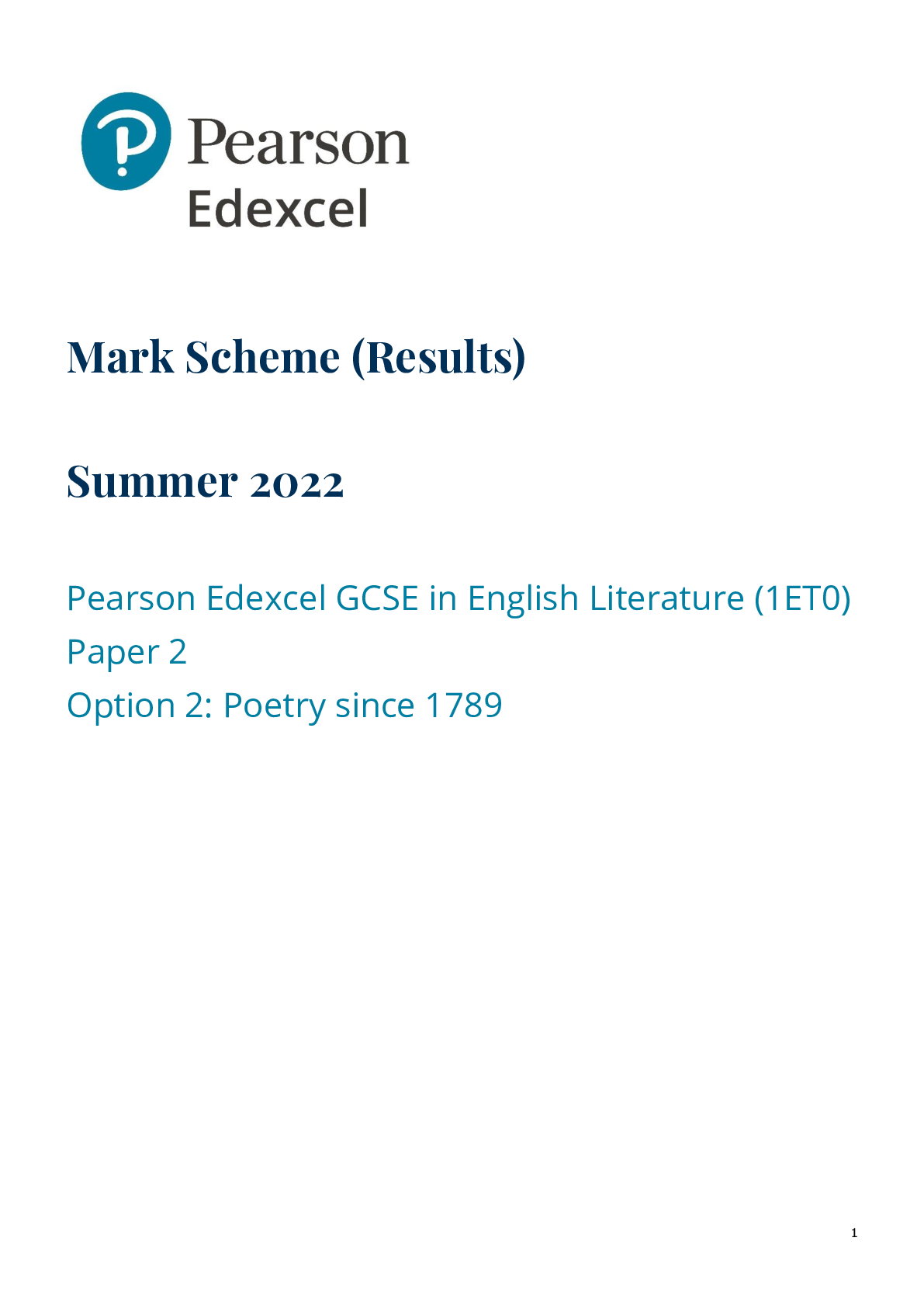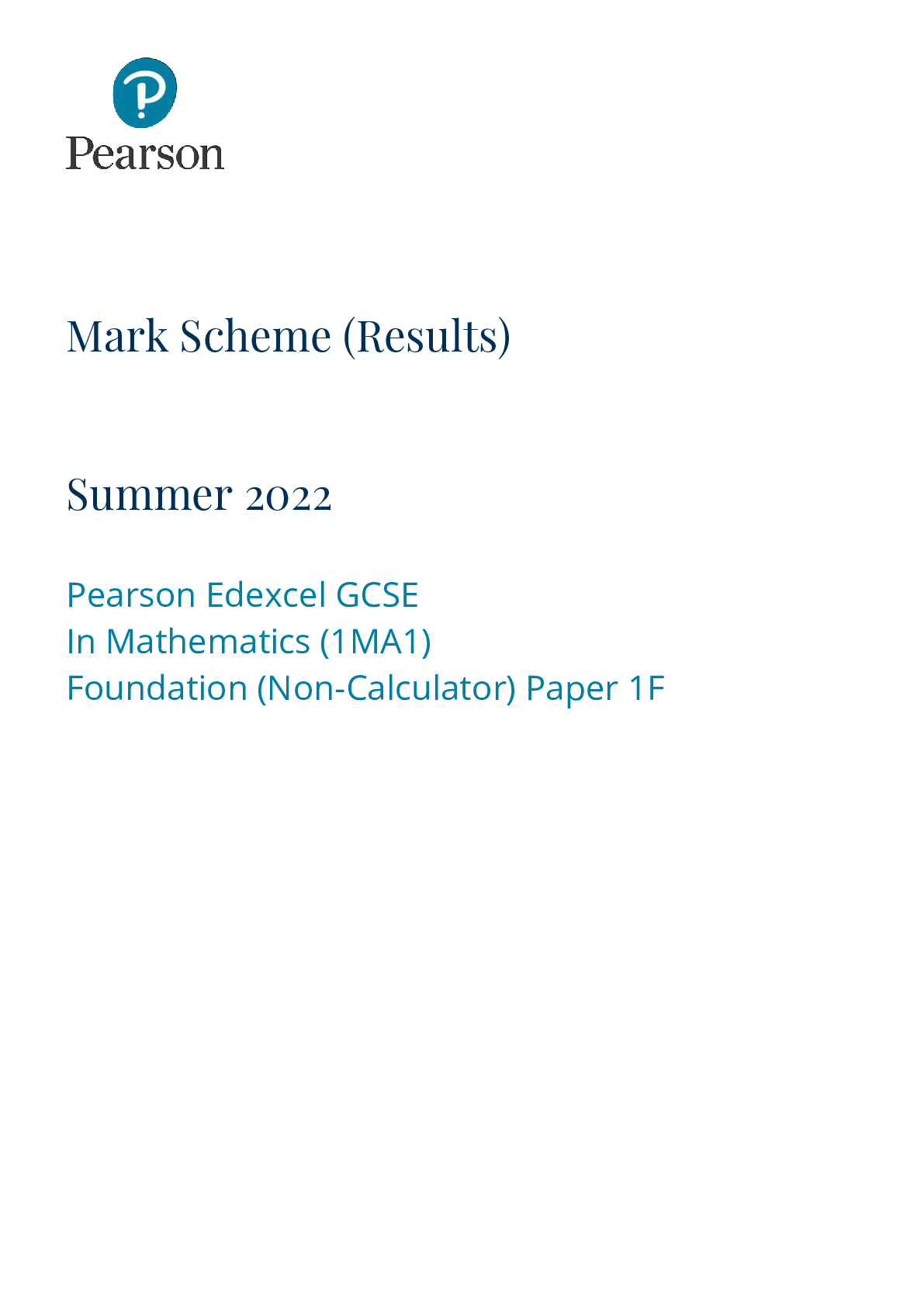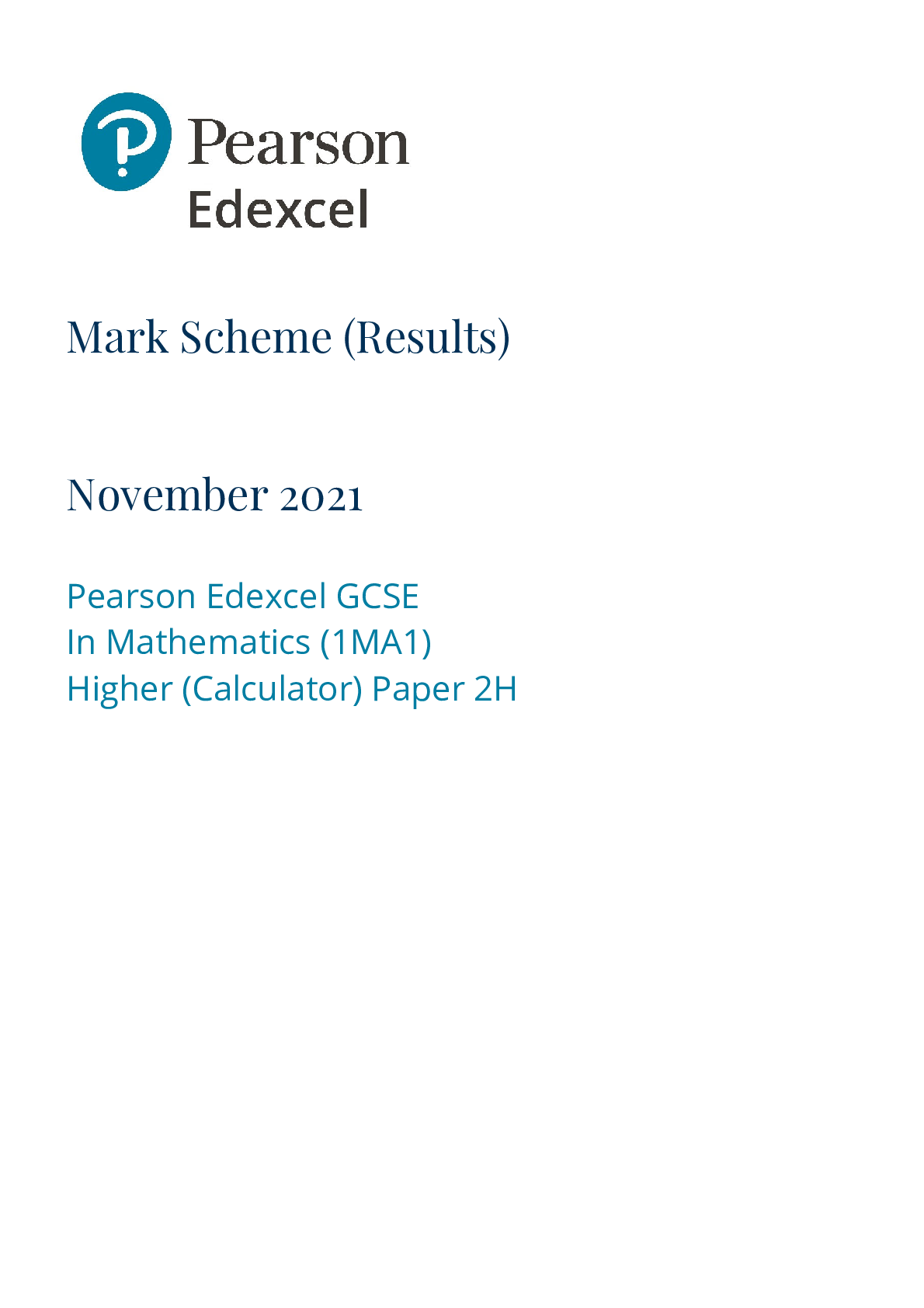Drama and Theatre > MARK SCHEME > Mark Scheme (Results) Summer 2022 Pearson Edexcel GCSE (9-1) Drama (1DR0/3A) Component 3: Theatre Ma (All)
Mark Scheme (Results) Summer 2022 Pearson Edexcel GCSE (9-1) Drama (1DR0/3A) Component 3: Theatre Makers in Practice Edexcel and BTEC Qualifications
Document Content and Description Below
Mark Scheme (Results) Summer 2022 Pearson Edexcel GCSE (9-1) Drama (1DR0/3A) Component 3: Theatre Makers in Practice Edexcel and BTEC Qualifications Edexcel and BTEC qualifications are awarded b... y Pearson, the UK’s largest awarding body. We provide a wide range of qualifications including academic, vocational, occupational and specific programmes for employers. For further information visit our qualifications websites at www.edexcel.com or www.btec.co.uk. Alternatively, you can get in touch with us using the details on our contact us page at www.edexcel.com/contactus. Pearson: helping people progress, everywhere Pearson aspires to be the world’s leading learning company. Our aim is to help everyone progress in their lives through education. We believe in every kind of learning, for all kinds of people, wherever they are in the world. We’ve been involved in education for over 150 years, and by working across 70 countries, in 100 languages, we have built an international reputation for our commitment to high standards and raising achievement through innovation in education. Find out more about how we can help you and your students at: www.pearson.com/uk Summer 2022 Question Paper Log Number 66350 Publications Code 1DR0_3A_2206_MS All the material in this publication is copyright © Pearson Education Ltd 2022 General Marking Guidance • All candidates must receive the same treatment. Examiners must mark the first candidate in exactly the same way as they mark the last. • Mark schemes should be applied positively. Candidates must be rewarded for what they have shown they can do rather than penalised for omissions. • Examiners should mark according to the mark scheme not according to their perception of where the grade boundaries may lie. • There is no ceiling on achievement. All marks on the mark scheme should be used appropriately. • All the marks on the mark scheme are designed to be awarded. Examiners should always award full marks if deserved, i.e. if the answer matches the mark scheme. Examiners should also be prepared to award zero marks if the candidate’s response is not worthy of credit according to the mark scheme. • Where some judgement is required, mark schemes will provide the principles by which marks will be awarded and exemplification may be limited. • When examiners are in doubt regarding the application of the mark scheme to a candidate’s response, the team leader must be consulted. • Crossed out work should be marked UNLESS the candidate has replaced it with an alternative response. Specific marking guidance Questions with higher mark tariffs each include indicative content and a mark grid. Each mark grid identifies which Assessment Objective is being targeted. When deciding how to reward an answer, examiners should consult both the indicative content and the associated marking grid(s). When using a levels-based mark scheme, the ‘best fit’ approach should be used. • Examiners should first decide which descriptor most closely matches the answer and place it in that level. • The mark awarded within the level will be decided based on the quality of the answer and will be modified according to how securely all bullet points are displayed at thatlevel. • Indicative content is exactly that – they are factual points that candidates are likely to use to construct their answer. • It is possible for an answer to be constructed without mentioning some or all of these points, as long as they provide alternative responses to the indicative content that fulfils the requirements of the question. It is the examiner’s responsibility to apply theirprofessional judgement to the candidate’s response in determining if the answer fulfils the requirements of the question. • In cases of uneven performance, the points above will still apply. Candidates will be placed inthe level that best describes their answer according to the descriptors in that level. Marks will be awarded towards the top or bottom of that level depending on how they have evidenced each of the descriptor bullet points. Pearson Education Limited. Registered company number 872828 with its registered office at 80 Strand, London, WC2R 0RL, United Kingdom Component 3: Theatre Makers in Practice – Mark Scheme Section A: Bringing the Text to Life A Doll’s House Question Number You are going to play Dr Rank. Explain two ways you would use non-verbal skills to play this character in this extract. Mark 1(a)(i) One mark for each way identified and an additional mark for each linked explanation. Candidates may refer to the following in their answer, for example: • Raised eyebrows (1) to indicate higher status than Niru (1) • Smiling (1) when teasing Niru (1) • Narrowed eyes (1) on ‘Anything wrong?’ to show concern. (1) • Stance/ movement used (1) to communicate strong emotions (1) • Gestures used (1) to indicate curiosity (1) or sympathy (1) Look for other reasonable marking points. (4) Question Number You are going to play Niru. She is frightened. As a performer, give three suggestions of how you would use performance skills to show this. You must provide a reason for each suggestion. Mark 1(a)(ii) One mark each for any three of the following points and one mark for each appropriate reason: • her physicality/movement in reaction to reading the visitor’s card (1) to show her anxiety (1) • use of space in the extract (1) e.g. as she nervously anticipates Das’ entrance (1) • her use of movement, and/or facial expression (1) to show tension when she greets Das (1) • change in tone (1) or volume (1)to show her rising emotions (1) • use of gesture when pleading with Das (1) to show her fear (1) • her physical reaction to Das at the end of the extract (1) to show that she is opposing his plan (1). Look for other reasonable markingpoints. (6) Question Number As a director, discuss how you would use one of the production elements below to bring this extract to life for your audience. You should make reference to the context in which the text was created and performed. Choose one of the following: • costume • set • staging. 1(b)(i) AO3 (9 marks) Candidates may refer to the following in their answers: costume: to indicate time period, character and/or status within the setting. Symbolic/representational costume with possible coordination with other chosen elements. Awareness of audience and ease of use for performers. Use of Saris,traditional 19th-century Indian jewellery and accessories, worn dhoti/ Punjabi for Das, contrast with Dr Rank’s westernsuit set: use of levels, specific examples of how the location is created for the audience, e.g. flats, projection or naturalistic set items to create the courtyard of the Victorian house in Calcutta, natural colours, scale used to suggest the ‘grand’ Helmer home, items such as plants, watering can used to indicate courtyard location staging: entrances and exits, awareness of audience and choice of staging configuration to create an appropriate space for performers and audience, e.g. proscenium arch/end on staging, sight lines, mezzanine level to create balcony positioning of doors as entrances/exits from the courtyard e.g. Rank’s exit, Das’ entrance The audience should be central to the response and reference should be made to the context in which the text was created e.g. traditional text first performed in 19th-century Norway, feminist themes shocking to original audiences, naturalistic production elements. There may also be links made to Calcutta setting, exploration of colonialism. Look for other reasonable marking points. Marking instructions This question requires understanding to be demonstrated through application of relevant and knowledge in the context of the question. Responses should show a balance of understanding and linked knowledge. Marks are equally distributed across knowledge and understanding. Responses that demonstrate isolated knowledge without linked understanding can only achieve a maximum of 3 marks. Level Mark Descriptor (AO3) 0 No rewardable material. Level 1 1–3 • Response is limited demonstrating basic knowledge withlimited understanding in relation to the chosen element. • Response tends to be mainly narrative and/or reported with an overall lack of focus in relation to the specifics of thequestion. • Examples are used but are underdeveloped or may not relate sufficiently to the extract or the chosen design element. • Reference to context is basic and may not always be appropriate, demonstrating limited knowledge and understanding. Level 2 4–6 • Response is competent demonstrating appropriate and generally balanced knowledge and understanding in relation to the chosen element. • Response is clearly expressed in some detail with consistent focus in relation to the question. • Examples used are developed and clearly supported by reasons that connect the response to the extract and the chosen design element. • Reference to context is effective and appropriate, demonstrating clear and generally balanced knowledge and understanding. Level 3 7–9 • Response is assured demonstrating comprehensive and balanced knowledge and understanding in relation to the chosen element. • Response is coherent and detailed with a high level of focus in relation to the question. • Examples used are well developed and supported by reasons that fully connect the response to the extract and the chosen design element. • Reference to context is embedded and fully supports discussion, demonstrating a secure and balanced knowledge and understanding. Question Number Das is being intimidating. As a director, discuss how the performer playing this role might demonstrate this to the audience in this extract and the complete play. You must consider: • voice • physicality • stage directions and stagespace 1(b)(ii) AO3 (12 marks) The question is specifically about the candidate as director making decisions about characterisation. The focus of the response should demonstrate an understanding of how a director working with a performer in a specific role might demonstrate status within the given extract. It should also show understanding based on the complete text. Specific examples will be supported by reasons for the decisions made, for example the intention for the performer in relation to the audience at specific times in the extract: • there may be evidence of, e.g. relationships within the extract that demonstrate an understanding of proxemics within the specific focus of the question • the audience should be central to the response. Candidates must consider use of voice, physicality and stage space in the response and may refer to the following in their answers: • voice: tone of voice and volumewhen threatening Niru, developed from initial greeting to heighten sense of intimidation. Pitch andpacechanges to heighten create sense that he is trying to bully Niru • physicality: use of gesture and movement to show his attitudeand the way that he is trying to influence Niru and her behaviour. Facial expression used to intensify this intention e.g. at ‘It would be a stupid thing to do’ • stage directions and stage space: use of stage directions to show interaction with and domination of Niru. Positioning in the space and how this is used to underline his coercion and control. Das is a low status character, both in terms of race and caste, and in this scene, his resentment of this can be demonstrated by his intimidating manipulation and domination of Niru’s moods and actions. By the climax to the play, he regrets his actions when he agrees to marry Mrs Lahiri and change his ways. Responses may refer to this. Marking instructions This question requires understanding to be demonstrated through application of relevant and knowledge in the context of the question. Responses should show a balance of understanding and linked knowledge. Marks are equally distributed across knowledge and understanding. Responses that demonstrate isolated knowledge without linked understanding can only achieve a maximum of 4 marks. Level Mark Descriptor (AO3) 0 No rewardable material. Level 1 1–4 • Demonstrates basic knowledge with limited understanding ofthe ways a director might explore and develop use of named elements. • Shows basic knowledge with limited understanding of how named elements are used in performance to communicatewith the audience. • Response tends to be mainly narrative and/or reported with a lack of focus and uneven consideration of the namedelements. • Examples may be used but do not fully support response. • Limited knowledge and understanding of the extract and complete text shown. Level 2 5–8 • Demonstrates competent and generally balanced knowledge and understanding of the ways a director might explore and develop use of named elements. • Shows clear and generally balanced knowledge and understanding of how named elements are used in performance to communicate with the audience. • Response is clearly expressed in some detail with consistent focus on the question and generally balanced considerationof the named elements. • Examples used are developed and clearly support response. • Competent and generally balanced knowledge and understanding of extract and complete text shown. Level 3 9–12 Demonstrates comprehensive and balanced knowledge and understanding of the ways a director might explore anddevelop use of named elements. Shows assured and balanced knowledge and understanding of how named elements are used in performance to communicate with the audience Response is detailed and highly focused on the questionwith comprehensive and balanced consideration of all elements. Examples are well developed and fully support response. Comprehensive and balanced knowledge and understanding of extract and complete text shown. Question Number There are specific choices in this extract for designers. Discuss how you would use one design element to enhance the production of this extract for the audience. Choose one of the following: • lighting • props/ stage furniture • sound. 1(c) AO3 (14 marks) The focus of the response should demonstrate how the chosen element would be used to enhance the production of this extract. Candidates may refer to the following in their answers: • there may be evidence of, e.g. the use of colour in lights to create specific moods or to focus attention on the setting and/or a relationship or a change of time and/or location • there may be evidence of how the props/ stage furniture, e.g. may create character, location or time, will either be aiming for realism or symbolism, could include the intention for the use of particular colours and textures, as well as the style of props/ stage furniture used • reasons for the decisions made, including, e.g. the reasons for either live or recorded sound/music and the intention for the use of particular sound/music effects at specific times in the extract. lighting: naturalistic use of light to enhance location/ time of day and to create mood/atmosphere e.g. to create the courtyard in the afternoon – sepia or straw wash to add warmth. Use of spotlight or colour to intensify moments between Niru and Rank, and/ or Niru and Das, change o [Show More]
Last updated: 1 year ago
Preview 1 out of 50 pages
Instant download

Buy this document to get the full access instantly
Instant Download Access after purchase
Add to cartInstant download
Reviews( 0 )
Document information
Connected school, study & course
About the document
Uploaded On
Apr 03, 2023
Number of pages
50
Written in
Additional information
This document has been written for:
Uploaded
Apr 03, 2023
Downloads
0
Views
48























